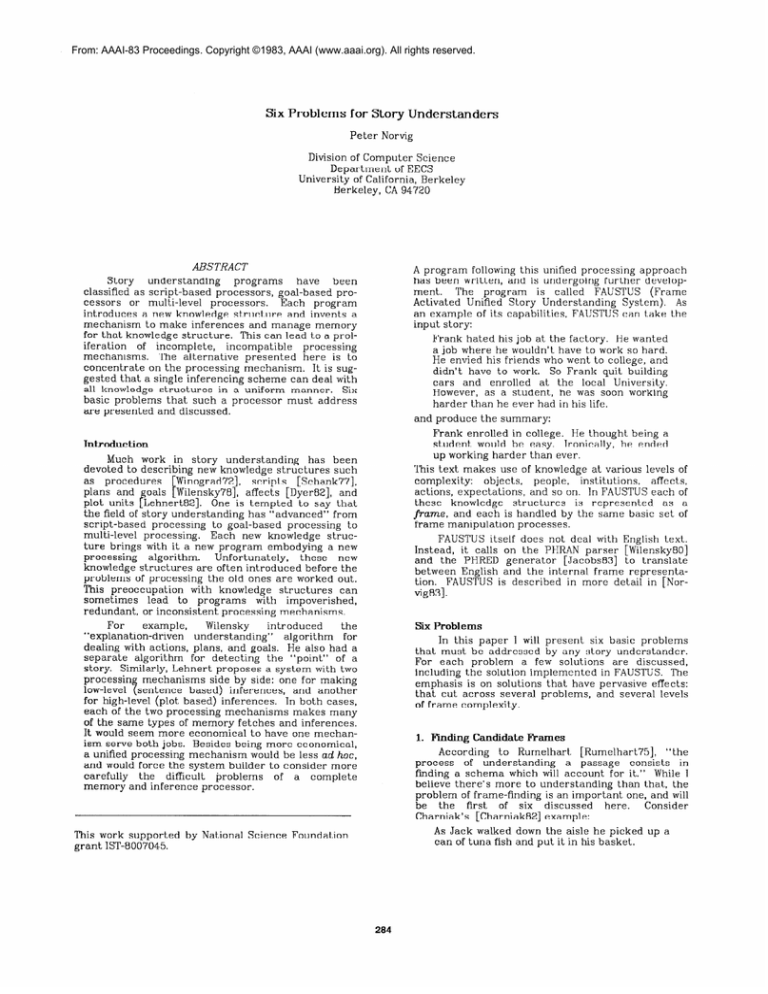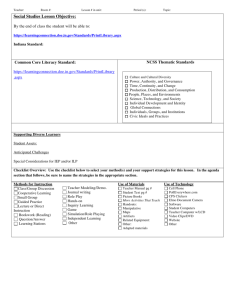
From: AAAI-83 Proceedings. Copyright ©1983, AAAI (www.aaai.org). All rights reserved.
Six Problems
for Story Understanders
Peter
Norvig
Division of Computer
Science
Department
of EECS
University
of California,
Berkeley
Berkeley,
CA 94720
ABSTRACT
Story
understanding
programs
have
been
classified
as script-based
processors,
goal-based
processors
or multi-level
processors.
Each
program
introduces
a new knowledge
structure
and invents
a
mechanism
to make inferences
and manage
memory
for that knowledge
structure.
This can lead to a proliferation
of incomplete,
incompatible
processing
mechanisms.
The alternative
presented
here
is to
concentrate
on the processing
mechanism.
It is suggested that a single inferencing
scheme
can deal with
Six
all knowledge
structures
in a uniform
manner.
basic problems
that such a processor
must address
are presented
and discussed.
Introduction
Much work
in story
understanding
has been
devoted
to describing
new knowledge
structures
such
as procedures
[Winograd72],
scripts
[Schank77],
plans and
oals [Wilensky78],
affects
[DyerBZ],
and
One is tempted
to say that
plot units f Lehnert82].
the field of story understanding
has “advanced”
from
script-based
processing
to goal-based
processing
to
multi-level
processing.
Each new knowledge
structure brings with it a new program
embodying
a new
processing
algorithm.
Unfortunately,
these
new
knowledge
structures
are often introduced
before the
problems
of processing
the old ones are worked
out.
This preoccupation
with knowledge
structures
can
sometimes
lead
to programs
with
impoverished,
redundant,
or inconsistent
processing
mechanisms.
introduced
the
For
example,
Wilensky
“explanation-driven
understanding”
algorithm
for
dealing with actions,
plans, and goals.
He also had a
separate
algorithm
for detecting
the “point”
of a
story.
Similarly,
Lehnert
proposes
a system with two
processin
mechanisms
side by side: one for making
low-level
based)
inferences,
and another
9 sentence
for high-level
(plot based)
inferences.
In both cases,
each of the two processing
mechanisms
makes many
of the same types of memory
fetches
and inferences.
It would seem more economical
to have one mechanism serve both jobs. Besides being more economical,
a unified processing
mechanism
would be less ad hoc,
and would force the system builder to consider
more
carefully
the
difficult
problems
of
a complete
memory
and inference
processor.
This work supported
grant IST-8007045.
by National
Science
Foundation
A program
following
this unified processing
approach
has been written,
and is undergoing
further
developis called
FAUSTUS
(Frame
The
program
ment.
Activated
Unified
Story
Understanding
System).
As
an example
of its capabilities,
FAUSTUS can take the
input story:
Frank hated his job at the factory.
He wanted
a job where he wouldn’t
have to work so hard.
He envied his friends who went to college,
and
So Frank
quit building
didn’t
have to work.
cars
and enrolled
at the local
University.
However,
as a student,
he was soon working
harder than he ever had in his life.
and produce
the summary:
Frank enrolled
in college.
He thought being a
student
would be easy.
Ironically,
he ended
up working
harder than ever.
This text makes use of knowledge
at various levels of
complexity:
objects,
people,
institutions,
affects,
actions, expectations,
and so on. In FAUSTUS each of
these
knowledge
structures
is represented
as a
pame,
and each is handled
by the same basic set of
frame manipulation
processes.
FAUSTUS
itself does not deal with English text.
Instead,
it calls on the PHRAN parser
[Wilensky80]
and the PHRED
generator
[Jacobs831
to translate
between
English
and the internal
frame
representation.
FAUSTUS
is described
in more detail in [Norv&83].
Six Problems
In this paper
I will present
six basic problems
that must be addressed
by any story understander.
For each
problem
a few solutions
are discussed,
including
the solution implemented
in FAUSTUS.
The
emphasis
is on solutions
that have pervasive
effects:
that cut across
several
problems,
and several
levels
of frame complexity.
1. Finding
Candidate
Fhmes
According
to Rurnelhart
[Rumelhart75],
“the
process
of understanding
a passage
consists
in
flnding
a schema
which will account
for it.” While I
believe
there’s
more to understanding
than that, the
problem
of frame-finding
is an important
one, and will
Consider
be
the
first
of
six
discussed
here.
Charniak’s
[CharniakSZ]
example:
As Jack walked down the aisle he picked
can of tuna fish and put it in his basket.
up a
The problem
is how to find the supermarketshopping
frame,
even though
it was never
explicitly
mentioned.
The solution
implemented
in FAUSTUS
relies
on spreading
activation
and hierarchical
composition.
The basic rule is that all parts of all frames
can potentially
be used to find a frame
(that is, we
are not restricted
to a small set of “triggers”
for
each frame),
but in practice
the following
system
is
used: (1) if the input matches
one unique frame, then
(2)
If a few frames
are
instantiate
that
frame.
matched,
consider
each one and try to make a choice
among them. (3) If the input matches
a large number
of frames,
spread “activation
energy”
to each frame,
and check
to see if the total
energy
exceeds
a
predefined
threshold
necessary
for instantiation.
As a final remark,
we note that
approach
can find the store-shopping
following
text,
while the spreading
rithm would not be able to:
As Jack walked
down
object off the shelf.
2. choosing
the
aisle
the hierarchical
frame
for the
activation
he picked
algoan
the Right Frame
Its easy to choose among candidate
frames when
there are contradictions
to rule out all but one candidate.
The hard part is weighing
the merits of several
frames,
none of which are obviously
incorrect.
Consider these
two sentences
(originally
presented
by
Paul Kay):
To put it another
way, if the input is unambiguous, interpret
it that
way.
If there
are
a small
number
of possible
meanings,
try to decide
among
them, and if there are a large number,
don’t even try
to make
a choice,
unless
one of the choices
has
already
been strongly
indicated.
Currently,
“a small
number’ ’ is defined
as four or less.
This triage
system is not restricted
to the problem
of finding candidate frames,
but is also used in choosing
the right
frame,
relating
new input to existing
frames,
and in
going from an abstract
to a more concrete
frame.
It
is a general
answer to the problem
of “choosing
(or
not choosing)
from several possibilities.”
(a) The florist sold a pair of boots to the Balerina.
(b) The cobbler
sold a pair of boots to the Alpinist.
In (a) we want to choose
a default
prototypical
selling
frame.
However,
in (b) we would be remiss
if
we didn’t choose
the commercial-transaction
frame;
we should make
the connection
that the boots are
from
the cobbler’s
shop, that the selling
is done
there, and that the Alpinist will probably
use them in
his
avocation.
This
interpretation
is preferred
because
it is richer than the interpretation
for (a); it
ties together
more
information.
FAUSTUS
tries
to
find interpretations
that account
for all of the input,
but it does not have any more sophisticated
decision
rules.
The concept
of spreading
activation
is not used
to actually
determine
what frames
to use, or to make
inferences,
but only to suggest possible
frames.
Decisions are made by a more discrete
process.
A delayed
way to rnake a choice is through
attrithe process
that drops frames
out of active consideration
over time.
Older frames
with lower initial
activation
are the first to go. Thus, if we are faced
with a choice of five candidate
frames,
and are unable
to choose
between
thern,
eventually
the candidate
frames will start dropping
out. Finally we will be left
with only one frame;
the one with the highest
initial
activation.
This is choice
by default.
There is some
evidence
that such choices
are reinforced
over time.
Consider the text:
tion,
Doctor
Smith
entered
the
She was the best open-heart
ical Center ever had...
operating
room.
surgeon the Med-
When FAUSTUS reads the word “she,” the representation for Doctor
Srnith is altered
to record
the fact
that she is female.
This overrides
the default,
but
causes no problems.
However,
if the text were part of
a novel, and twenty
pages had elapsed
between
the
time Doctor
Smith was introduced
and the time the
doctor
was referred
to as “she,”
why might
the
reader
then be surprised?
I submit it is because
the
candidate
frame female-doctor
dropped
out by attrition, and the male-doctor
frame
(with its higher
a
priori activation)
was chosen by default.
At this point
it cannot
be changed
without
noticing
a contradiction. Paul Kay [Kay811 discusses a similar example.
3. Relating
New input to Existing
Contexts
Many inputs should not instantiate
new frames,
but rather
fit in as part of an existing
instantiated
frame.
In
[Wilensky78]
it was proposed
that the
understander
should first try to interpret
the input
as elaborating
an existing
frame,
and if that fails to
try to find a new frame.
In [Wong81]
the algorithm
is
to consider
simultaneously
any existing
frames
the
input might match and a novel frame created
on the
spot.
285
Orthogonal
to those two algorithms
is the choice
of where to look first.
One possibility
is to look in all
currently
activated
frames
for unfilled
slots
that
match
the current
input.
This may be slow if there
are many active frames,
and if we have to go through
them linearly.
The alternative
is to look first in the
generic
knowledge
data base (as we did to find candidate frames
in the first place)
and then if we do find a
match,
check
to see if there
are any frames
of the
proper
type currently
instantiated.
4. Recovering
from
an Incorrect
Choice
One mark
of a good story understander
is the
ability to back up, replacing
an incorrect
assumption
with an alternative
when the story merits it. Granger
(and
[GrangerEIl]
h as worked on a story understander
a question
answerer)
with this ability.
The problem
is
really
three-fold:
recognizing
that
an error
has
occurred,
locating
the error,
and correcting
it. The
hard part is locating
the error.
It would be easy if
each frame had a list of concepts
that are not part of
the frame,
but obviously
we can not afford to store
that kind of knowledge.
FAUSTUS
makes
the third
task easier by keeping
candidate
frames
around (in a
separate
data base) for a short time after they are
discarded
as inappropriate.
This makes the problem
of selecting
a new frame
identical
to the problem
of
selecting
an old one, provided
the candidate
frames
have not yet been lost through
attrition.
Consider
the following
text:
As Jack walked down the aisle he picked up a
can of tuna fish and put it in his basket.
As a
janitor at the stadium,
he had to pick up a lot
of trash after a big game like this one.
The reader
decides
on the
frame
after
the first sentence.
tence the location
of stadium
tion supermarket.
FAUSTUS
pares
the supermarket-shopping
stadium-janitor
scenario,
and
the later scenario
accounts
for
supermarket-shopping
In the second
senconflicts
with the locathen backs
up, comscenario
with the
determines
that only
all the inputs.
Notice
that
the
ability
to back
up requires
meta-knowledge
of what
knowledge
was acquired
through
input, through
inference,
or through
default.
As discussed
above
in problem
2, the distinction
between
default
and input
probably
becomes
lost
over time.
286
Jacobs83.
Jacobs, Paul, “Generation
in a Natural Language
Interface,”
Proceedings
of the 8th IJCAI, (1983).
Kay8 1.
Kay, Paul, Three Properties
Berkeley
Cognitive
Science
of the Ideal Reader,
Program
(1981).
Lehnert82.
Lehnert,
Wendy G., “Plot Units: A Narrative
Summarization
Strategy,”
pp. 375-4 14 in Strategies
for Natural Language
Processing,
ed. Martin H.
Ringle,Lawrence
Erlbaum
Associates,
Hillsdale,
NJ (1982).
Norvig83.
Norvig,
Peter,
“Frame
Story Understanding
the 8th IJCAI, (1983).
Activated
Program,”
Inferences
Proceedings
in a
of
Rosch78.
Rosch, E., “Principles
of Categorization,”
in Cognition
and
Categorization,
ed.
B.B.
Lloyd,Lawrence
Erlbaum
Associates
(1978).
Rumelhart75.
Rumelhart,
David,
“Notes
on a schema
for
stories,”
pp.
21 l-236
in Representati,on
and
Understanding,
ed. A. Collins,Academic
Press,
New York (1975).
Acknowledgements
Many of the ideas expressed
here were developed
jointly with Joe Faletti,
Marc Luria, Robert Wilensky,
and other members
of the Berkley
AI Research
group.
Joe Faletti
and I also worked
together
on a prelimof the
frame
manipulation
inary
implementation
package;
this package
was shared
by FAUSTUS
and
PANDORA, Faletti’s
problem
solving program.
Schank77.
Schank,
Roger
C and Robert
P. Abelson,
‘I ” in
Scripts,
Plans,
Goals and Understanding,
’ Erlbaum,
Hillsdale,
N.J (1977).
Wilensky80.
Wilensky,
Robert
and Yigal Arens, “A Knowledgebased
Approach
to Natural
Language
Processing,”
Memorandum
No. UCB/ERL/M80/34,
UC
Berkeley
ERL, Berkeley
(1980).
References
Wilensky78.
Wilensky,
Stories,
Research
CharniakBZ.
“Context
Recognition
in
Charniak,
Eugene,
Language
Comprehension,”
pp. 435-454 in Strategies for Natural Language Processing,
ed. MarErlbaum
Associates,
Ringle,Lawrence
tin
H.
Hillsdale,
NJ (1982).
Winograd72.
Winograd,
Language,
Dyer82.
Processing
for NarraDyer, Michael
G., “Affect
Proceedings
of the National
Conference
tives,”
on Artificial Intelkigence,
pp. 265-268 (1982).
Robert
W., Understandin,g
Goal-based
Yale
University
Corn uter
Science
Report,
New Haven, CT. P1978).
Terry,
Academic
Understanding
Press, New York
Natural
(1972).
Wong81.
Wong, Douglas,
“Language
Comprehension
in a
Problem
Solver,”
Proceedings
of the Seuenth
IJCM, pp. 7-12 (3 981).
GrangerEl.
and Re-Directing
Granger,
Richard H., “Directing
Inference
Pursuit:
Extra-Textual
Influences
on
Text Interpretation,”
Proceedings
of the Seventh
IJCXI, pp. 354-361 (1981).
Granger82.
Granger,
Richard
H. and Jennifer
K. Holbrook,
“Perseverers,
Recencies
and
Deferrers:
New
experimental
evidence
for
multiple
inference
Information
strategies
in understanding,”
??,
and Computer
Science,
U.C. Irvine,
Irvine,
CA
(1982).
287





